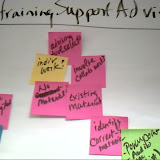Final Thoughts
Can this really be my final blog entry for the Immersion program? I can't believe how much the team accomplished in a little over 9 months and how much I have learned. We had our final presentation for the client Monday night. In attendance were GMU administrators, Immersion alums, and local ID professionals. The client and T/TAC staff at the presentation were impressed with our final result. I presented on the results of our usability testing of the Virtual Collaboration Center prototype. I also provided a demonstration of the current iteration of the prototype and gave a persona "walk-through" of the Training Collaboratory.
Looking back, I can't believe how much I have been exposed to during my experience in Immersion. Camtasia, wikis, blogs, Facebook, etc. All this exposure to Web 2.0 has even impacted my leisure time activities. Instead of taking a break by plopping down in front of the TV for 15 minutes, I play around in Facebook. I am willing to try emerging technologies whereas before I would have preferred to lurk. Heck, I even have a virtual resume and portfolio. I now have friends I never met face-to-face, and the number of my virtual friends keeps growing.
Above all, I had some things confirmed - I am a process person at heart and Instructional Design is all about process. When I first started grad school 1 1/2 years ago, I was completely scared not knowing where this would take me, but I am feeling confident about my career prospects for the first time in years. I have also realized that I need to keep my mental muscles fit by exercising them regularly through education. Does that mean a Ph.D. is in order? Stay tuned ...






